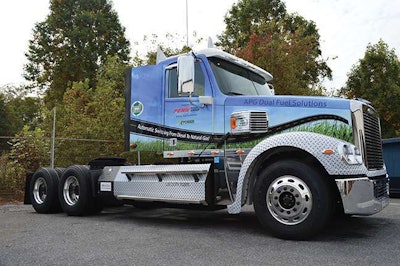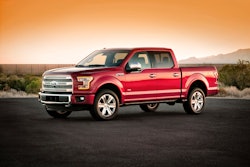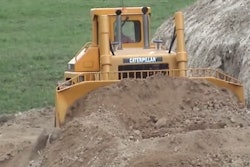
The first part of my test drive began westbound on Interstate 80 out of Salt Lake City, on the level desert run that leads to the Bonneville Salt Flats.
The goal then had been to find flat ground and a little traffic to give me a feel for the truck. But now, we’d doubled back and were climbing the Wasatch Mountains east of the city on I-215 leading to I-80 East toward Park City. Here, I’d get a chance to pull some serious mountain grades and see for myself if a dual-fuel diesel-ignited natural gas truck engine was up to hauling 44,000 pounds in demanding terrain.
Starting up the first grade, the road suddenly began a series of winding S-turns at the same time that construction took a couple of lane options off the table. The truck was pulling well, but I grabbed another gear just to be on the safe side. It was the most remarkable thing that occurred during my test drive.
That’s not a slam against the Freightliner Columbia I was driving, but rather a vindication that this rig—a glider kit fitted with a refurbished diesel engine that itself was retrofitted with an American Power Group natural gas fuel system—had performed exactly as the folks at APG, the Wheel Time Group and Smith Power, the manufacturer of the truck, had assured me it would.
What lies beneath?
Glider kit builders, sales and support provider Wheel Time, natural gas supplier Blu and APG have teamed to introduce natural gas glider kits to the North American trucking industry. Contractors wishing to find an affordable way to get into the natural gas game can spec glider kits with retrofit fuel systems and save as much as $40,000 on the vehicle compared to purchasing a new, dedicated natural gas truck. A further enticement is that you can spec older pre-exhaust gas recirculation emissions engines to power these trucks – and enjoy more reliable power and serviceability in the bargain.
My test rig was a 2014 Freightliner Columbia daycab truck. On the outside, even seasoned industry veterans would be unable to tell that this truck was anything other than a new Columbia. Climbing into the cab, that reaction was further reinforced: The interior still had a factory-fresh smell with modern instrumentation and gauges, mirrors and ergonomics. Because the truck had been spec’d as a regional-haul daycab, its interior appointments were basic. But if a contractor wanted to upgrade the interior with the latest Daimler diagnostic and telematics systems, it wouldn’t be a problem.
It was underneath the hood and cab where the real differences this tractor offered could be found. Pulling the hood forward didn’t reveal the new selective catalytic reduction-equipped DD12 one would expect to see. Instead, I was greeted with a concrete-gray 1996-vintage Series 60 Detroit Diesel engine, complete with vibrant blood-red lettering scripted across the engine block.
Glider kits take advantage of a quirky loophole in truck manufacturing laws that allow fleets to purchase a truck with a new cab and chassis, fitted with a recycled or refurbished drivetrain. The additional twist—thrown into the mix by APG, Wheel Time and their partners—is that their rebuilt powertrains receive the further addition of a natural gas fuel and tank system. The system manages the flow of the two fuels to the engine, using diesel both as the ignition source in the combustion chamber and as a power boost in situations demanding higher torque from the engine.
So when the truck is just getting rolling or climbing a steep mountain grade, the system supplies larger amounts of diesel to the engine—up to 50 percent of the fuel supplied, depending on road and terrain conditions—and then dials that ratio back as engine load demands decrease. So on my flat run heading west, the engine was using a minimum of diesel—only a little shot to initiate combustion—while the cheaper natural gas kept the wheels turning. Later in the mountains, the system delivered a significantly higher percentage of diesel to the combustion mix to make sure I had plenty of power to deal with the hilly terrain.
On the road, the truck handles and drives exactly as one expects: it is, after all, a new truck. The only indications that something unusual is happening are an electronic fuel system monitor on the dash—which shows the driver the diesel-to-natural gas fuel ratio—and the noise level in the cab. Although the truck is new, it has a 20-year-old engine under the hood that—despite the technological upgrades it has received in its current incarnation—is louder than new ones that come out of factories today, so some more pronounced drivetrain noise is to be expected.
Most importantly is the performance of the fuel system in actual driving conditions, which was why my Salt Lake hosts were so eager for me to drive the truck in the nearby mountains. The dual-fuel system delivered in spades; the glider kit pulled as well as any truck on the highway. The truck was loaded with about 44,000 pounds in the box and had no problem dealing with any grades—up to 6 in percent in some areas. This is clearly a system that works on the driver’s behalf to get the job done.












